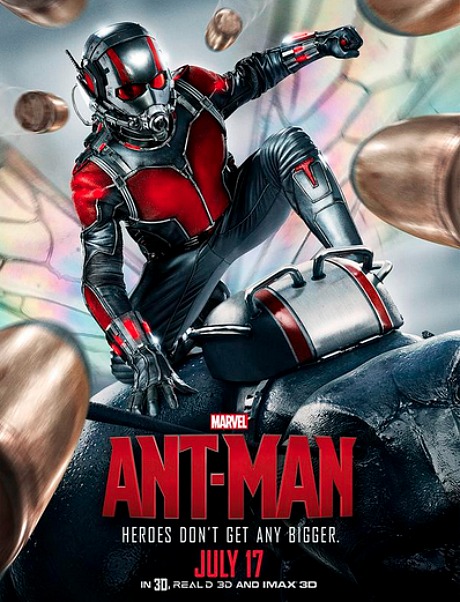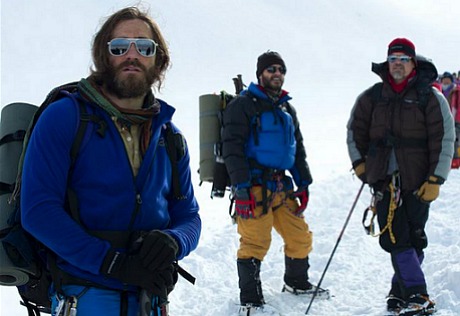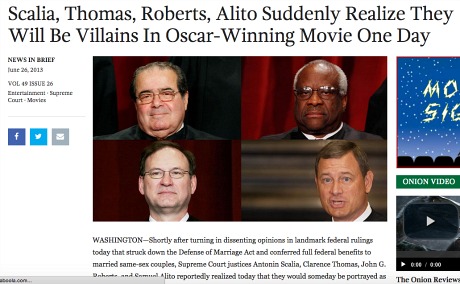Two or three weeks ago I finally saw John Crowley‘s Brooklyn (Fox Searchlight, 11.6), which I’d missed at Sundance. Except I saw it on a third-generation DVD dupe, and so it looked and sounded like hell. So I’m “seeing” it for the first time, in a sense, via the trailer. The raves, in any event, are fully justified. This is a solid, heartfelt, seriously romantic winner — classic and “old school” in the finest sense of that term. Best Picture prospects seem assured, and Saoirse Ronan (again — her first name is pronounced “Sersha”) is a near-lock for a Best Actress nomination. Ditto Crowley for Best Director and Nick Hornby for Best Adapted Screenplay. Here’s to seeing it again under proper theatrical circumstances.
Daily
Ant-Man — A Total Kick, Often Hilarious, Disciplined Like A Marine
I went into last night’s Ant-Man screening with an attitude, but it surprised the hell out of me. It’s basically a dry, highly disciplined, emotionally grounded, bang-on comedy. It doesn’t try to sell or invest in the usual Marvel fantasy fizz — it fucks with it, turns the whole thing into a joke. It’s so much better than I expected that you could call me flabbergasted. Surprising as this may sound (especially to me), Ant-Man is my favorite Marvel film yet. The Hollywood Reporter‘s Todd McCarthy said yesterday it’s not quite as engaging as Guardians of the Galaxy; I think it’s a little bit better.


I know — I lack the authority to judge Marvel films because I’m too much of a comic-book-movie hater, right? What I really am is an Avengers and Iron Man-sequel hater, an enemy of glum superhero angst, and definitely a Robert Downey loather. All I know is that I didn’t frown or moan once last night. I grinned, chuckled, felt more or less delighted. I loved the visual roller-coastery, sudden-size-shift stuff…the swooping down from life-size to micro-size and back up again — a game that basically unfurls an entirely new micro-realm. No mood pockets, no prickly detours…pretty much all pleasure.
Yes, Ant-Man is “silly” but it embraces that. It’s sharp and fast and disciplined as a Marine. It takes itself seriously in terms of its own efficiency and (I’m serious) its own emotional undercurrents. So call me turned around and converted.
Take no notice of the piss-heads who are saying “if only original director Edgar Wright hadn’t bolted!” These guys are coming from an obsessive geek-wanker place and are not to be trusted. They’re just standing behind Edgar and against Marvel/Disney for loyalty’s sake. I realize that Wright bailed due to Marvel intransigence or Disney-level meddling. And I’ll allow that Shaun of the Dead showed that he has a flourishy attitude and a certain auteurist panache, but, unlike a few geek-influenced critics I could name, I don’t think he’s God’s gift because Scott Pilgrim vs. the World made me want to jump off a 15-story building.
Land of Free, Home of Jabbas
An absurd story broke this morning on TMZ, about video footage of Ariana Grande and a boyfriend visiting a Lake Elsinore donut shop. An employee brought out a large tray of donuts and Grande said, “What the fuck is that? I hate Americans…I hate America.” TMZ has called the remark scandalous, “fat shaming on a national scale.” Some believe Grande may have hurt her career. Expressing disgust at obesity and the foods that cause it is, of course, sacrilege in these twisted times. Love America, love the obesity. The latest CDC figures say more than one-third of Americans are obese. And that “non-Hispanic blacks have the highest age-adjusted rates of obesity (47.8%) followed by Hispanics (42.5%), non-Hispanic whites (32.6%), and non-Hispanic Asians (10.8%).” So by all means, throw Grande to the lions and may other celebrities take heed.

Unlikely Dream
There’s a Los Angeles for Bernie Facebook page but no Bernie Sanders for President storefront in Los Angeles, apparently. I wanted to pick up a few buttons and bumper stickers but no one seems to have any. So I ordered a few online. I’ll be donating $100 but I’d like to attend a rally or something. I don’t how much good I’d accomplish handing out literature in Gardena or Alhambra or El Monte.

A friend complained today that sharing my honest thoughts about Hillary Clinton was feeding right into a concerted effort by conservatives to try and goad liberals into putting her down online. “I feel for her deep down,” I replied. “I mostly agree with what she wants to do as President. I don’t want her to lose, particularly to a Bush or a Rubio, God forbid. She’ll ultimately be the best alternative, I regret to say, given the strong likelihood that Bernie can’t go the distance. But I don’t like Hillary. I never have. She doesn’t turn me on. She sort of irritates me. And I can’t not say that, given my natural inclinations.”
“Fundamentally Silly” Story, Not As Good As Guardians, But Amusing, “Reasonably Disarming”
“If you don’t have Thor’s hammer, Hulk’s bulk, Captain America’s resolve or Iron Man’s know-how, what’s an Avenger to do? The answer provided by Ant-Man is to go small, smaller than Black Widow’s fingernail, and exude a good sense of humor, which is precisely what floats this latest addition to the Marvel firmament,” writes Hollywood Reporter critic Todd McCarthy. “The timing might even be fortuitous as far as the fan base is concerned, what with the sense of overkill emanating from the most recent Avengers installment and a mirth quotient in the new outing that, by Marvel standards, ranks behind only that of the disarming Guardians of the Galaxy last summer.
“Although the story dynamics are fundamentally silly and the family stuff, with its parallel father-daughter melodrama, is elemental button-pushing, a good cast led by a winning Paul Rudd puts the nonsense over in reasonably disarming fashion.
“The geek world, even if it approves what has finally emerged onscreen, will still always wonder what Ant-Man would have been like if, as originally intended, Edgar Wright, he of Shaun of the Dead and Scott Pilgrim vs. the World cultish veneration, had directed the screenplay he wrote with Joe Cornish. Would it have been more extreme, irreverent, idiosyncratic and, in the end, less Marvel-like?
Perfect Storm in Winter, Same New England Accents, Happier Ending
True-life tale of a 1952 rescue mission off the Cape Cod coast after two oil tankers, SS Fort Mercer and SS Pendleton, were destroyed by a collision in the midst of heavy waves. Have heaving CG seas improved since the days of The Puhrfict Stauhm? You tell me. Directed by Craig Gillespie (Lars and the Real Girl). Clearly all the actors — Chris Pine, Casey Affleck, Ben Foster, Holliday Grainger, John Ortiz, Eric Bana — attended the same New England accent school.
They Died With Their Climbing Boots On
I was a bit surprised to read that Baltasar Kormakur‘s Everest (Universal, 9.18) will open the 72nd Venice Film Festival on Wednesday, 9.2. Out of competition, of course. I’m sure it’ll be pretty good for what it is (a tragic, fact-based disaster film), but Kormakur’s Contraband and 2 Guns made it clear that he’s more or less Renny Harlin of the early ’90s. Pretty much all the male leads die in this, right? Jake Gyllenhaal, Jason Clarke, Josh Brolin, Sam Worthington, John Hawkes and Michael Kelly. With Keira Knightley, Emily Watson and Robin Wright fretting as sketchy reports come in. Everest will almost certainly not be a Telluride film…right?

Half Typical Spielberg, Half Possibly Not Too Bad
The new British-made trailer for Steven Spielberg‘s Bridge of Spies (Disney, 10.16) is a significant improvement over last month’s teaser. It still has that trademark bluish-white Janusz Kamsinski cinematography, which I loathe with a passion, but it lays out the social and political context of the late Eisenhower era and delivers a more precise portrait of U.S. vs. Soviet tensions when the Francis Gary Powers U2 incident happened in May 1960. Spielberg and Hanks were kids when this shitstorm happened, and so there’s likely to be an extra measure of authority in the depictions of those times. Hanks’ 17th version of his man-of-character-and-infinite-patience thing, etc.
Kael Doc Still In The Pit
Rob Garver, director of the forever-gestating What She Said: The Art of Pauline Kael, needs $75K to finish the film, which I had expected (emphasis on the “had”) would be hitting the fall festivals. I guess not. Okay, I’ll contribute $100 but it profoundly bothers me when a trailer has a slightly wider than correct aspect ratio. I’m not talking about the Kickstarter pitch as much as the Vimeo trailer posted after the jump. I hate the horizontal taffy-pull look. Fix it, please.
“If we go back and think over the movies we’ve enjoyed—even the ones we knew were terrible movies while we enjoyed them—what we enjoyed in them, the little part that was good, had, in some rudimentary way, some freshness, some hint of style, some trace of beauty, some audacity, some craziness….They have the joy of playfulness. In a mediocre or rotten movie, the good things may give the impression that they come out of nowhere; the better the movie, the more they seem to belong to the world of the movie. Without this kind of playfulness and the pleasure we take from it, art isn’t art at all, it’s something punishing, as it so often is in school where even artists’ little jokes become leaden from explanation.” — from a Pauline Kael piece called “Trash, Art and the Movies,” from “Going Steady.”
Sometimes It All Just Works
I’m off to see Trainwreck again tomorrow night, and I can’t wait. I know when a movie has its shit together and when it doesn’t, and apart from third-act disputes and discussions (which are fair to kick around) Trainwreck is two or three cuts above. It does the conventional relationship thing in a dryer, sharper, deep-down way. For the deadpan hilarity alone you can’t not see it. Smarts, depth, poignant perceptions, gut-level honesty — qualities obviously owned by Amy Schumer but not, I regret to observe, abundant among Kate Upton types. Prevalent now and then but not abundant. I wish it were otherwise.
“Perhaps most surprising, though, is what a strong performer Schumer proves to be,” says Screen Daily‘s Tim Grierson. “On her Comedy Central show, she’s quite funny in short sketches, but here she gets the chance to play a multi-dimensional character. The actress-comedian makes Amy’s childishness endearing while also recognising its shortcomings.
Almost Freakishly Real
I would definitely pay to see this guy, Anthony Ingruber, play young Han Solo in that dopey-sounding prequel that the LEGO Movie guys are making. The looks, the Ford voice, the attitude, the right age…nailed cold. Now watch the producers ignore him…assholes.
Casting Suggestions?
Variety and the N.Y. Times reported this afternoon that Twentieth Century Fox is developing a film about the Supreme Court’s recent marriage-equality ruling. Fox has acquired the life rights of Jim Obergefell, the lead plaintiff in the lawsuit that went to the court. To cover their bases the studio has also bought life rights to Obergefell’s attorney Al Gerhardstein.

On 6.26 The Onion ran a piece about such a project, beginning with the following:
“WASHINGTON — Shortly after turning in dissenting opinions in landmark federal rulings today that struck down the Defense of Marriage Act and conferred full federal benefits to married same-sex couples, Supreme Court justices Antonin Scalia, Clarence Thomas, John G. Roberts and Samuel Alito reportedly realized today that they would someday be portrayed as villains in an Oscar-winning film about the fight for marriage equality.
“’Oh, God, the major social ramifications, the political intrigue, all the important people involved in the case — I’m going to be played by some sinister character actor in a drama with tons of award buzz, aren’t I?” said Scalia, joining his fellow dissenting justices in realizing they would be antagonists in a film potentially titled Defense Of Marriage and probably written by Tony Kushner.
